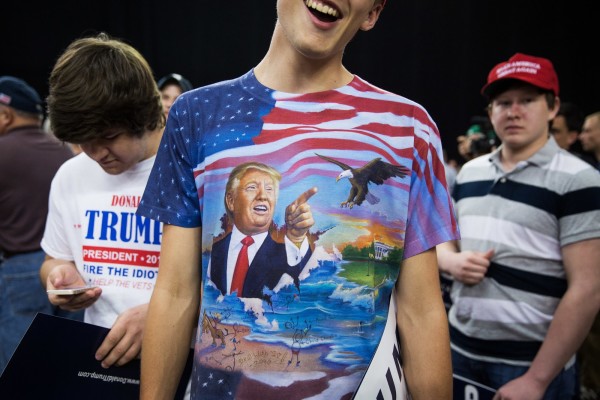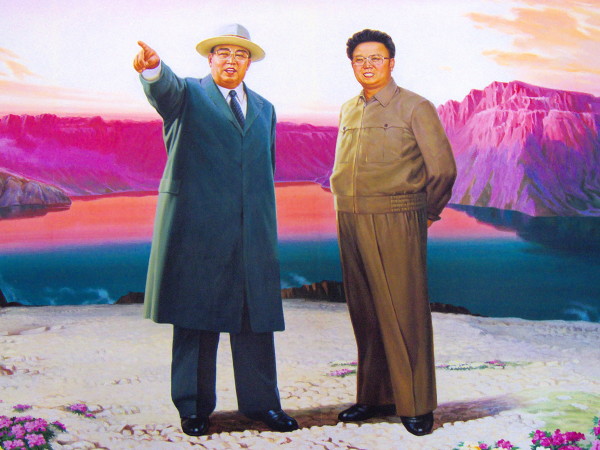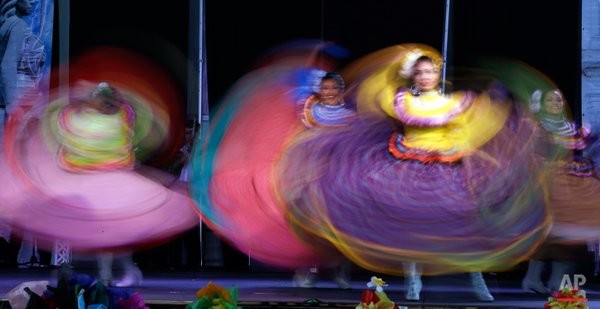Notes
Kim Jong Trump: A Good Fit?

News photography is pretty good at putting political symbolism on display, but sometimes politics gets so otherworldly that it needs help from an illustrator first. This update on patriotic kitsch was spotted at a Trump rally in Harrisburg, PA just last week, and the photograph made New York Times photos of the week. As a piece of visual commentary, the photograph shows how mythical imagery and catchy slogans work similarly on the imagination, even if we’re not entirely comfortable parading them around publicly. Beyond whatever symbolic work the photograph can do on its own, though, there’s something about the visual flexibility of illustration that can actually get us closer to the truth of the matter, especially when it comes to the way politics affects matters of the heart.
It has been said that the invention of photography liberated the plastic arts—like painting and sculpture—from the burden of “realistic” representation. The camera’s mechanistic eye was believed to capture reality in the raw, exactly how things are, so artists could finally stop trying to make pictures look like real life and get back once again to drawing and painting all the mythic and symbolic stuff. After all, the idea that an artist could faithfully reproduce three-dimensional reality on a two-dimensional canvas usually came with a knowing wink that the trick is optical illusion. Back before Leonardo da Vinci perfected the technique of three-dimensional perspective, artists didn’t much care if their images faithfully mimicked the real world or not. Those were more mythical times, we assure ourselves, when everyone accepted that the function of art was to depict truths that transcend the figural confines of time and space.
That old belief in the transcendence of higher truth is one of the keys to understanding how religious devotional art still works today, and it goes a long way toward explaining the appeal of this guy’s t-shirt. Like the illusory image of Trump tearing through the painter’s canvas—that reliable sign of establishment conventions—the higher truth scoffs at any attempt to be closed in by people’s expectations. Higher truth ruptures, violently if need be, any blueprint for keeping it contained. So if that’s not the way you see it then the joke’s on you, loser. Deal with it (2016!). Because the thing about higher truth is that only the ones who already “get it” can see it anyway. That it’s a bit tongue-in-cheek doesn’t matter, either. The scene perfectly illustrates a truth that only the Trump faithful can truly see.

Now, if you’re picking up on that eerie similarity between this kitschy collage and the visual hallmarks of North Korean depictions of the Kim Il Sung dynasty, we should point out that the correspondence may not be intentional, but it is no coincidence, either. Visual glorification of the great leader has its own set of conventions, and when it comes to illustrating a story about irresistible populist appeal, those conventions might be where Trumpism makes for a good, comfortable fit.
–Philip Perdue
(photo: Damon Winter / New York Times. caption: High school students waited to see Donald J. Trump at a campaign rally in Harrisburg, Pa., on Thursday. illustration: )
![There [Won’t] Be Blood: On the Newsweek Tampon Cover](https://www.readingthepictures.org/wp-content/uploads/2016/05/ONE_20160429cover1800-x-2400-600x800.jpg)

Reactions
Comments Powered by Disqus